The pitiful backpedaling and fabrication of fake news from sweaty Leftistan has reached new heights in recent days. While unfolding their petty attacks on French history and culture is a perfectly well-honed exercise for them, recognizing them seems another matter! It is here that we could admire all the cowardice, the lack of culture, the stupidity and the contempt of this small caste of subsidized rebellocrats, only good at denying the obvious and stammering out enormities (« Dionysus [Greek god], is the father of Sequana [Gallic goddess of the River Seine], didn’t you know that? ») when it came to assuming their easy provocations.
Flying to the aid of Thomas Jolly, executor of the deconstructivist fantasies of the historian Patrick Boucheron, co-author of the opening ceremony – who therefore, as a specialist in the Renaissance, knows perfectly well what his painting « Festivity » represents –, Philippe Dagen, another lookout for the cultural left, yesterday wrote this improbable article in Le Monde, the gazette of state ideology:
« JO de Paris 2024 : quand les autorités catholiques confondent le banquet de Bacchus avec le dernier repas du Christ lors de la cérémonie d’ouverture » (Le Monde, 29/07/2024)
When, like me, you have a little (a lot) of Christian, historical and artistic culture, you rub your eyes and then fall off your chair when you discover that Philippe Dagen, official critic of official art, court critic of court art for decades, does not have the slightest reference up his sleeve in terms of Christian iconography!
Mr. Dagen, who is nevertheless accustomed to seeing the endless parodies of Christian art parade by the contemporary art scene – they only know how to do that, divert, parody and shit on their predecessors – is therefore unable to recognize a double parody of the Last Supper (whether the Milan fresco of Leonardo da Vinci or even the now famous Biljert canvas, recognized as a parody of the institution of the Eucharist, the result is the same: it is in all cases a pastiche of the Last Supper!), nor the Christian tradition having since its origins (the early Christian era), integrated the Dionysian symbolism around wine into the development of its own symbolism of the Eucharist.
And it is Mr. Dagen who, from the height of his ignorance, claims to come and give lessons to ministers of religion who, for nearly 2000 years, know that the wine of Dionysus (or Bacchus) is also linked to the symbolism of the Eucharistic species!
Mr. Dagen has clearly never taken the slightest course in Christian iconography, he has never even opened a book on the symbolism of classical, Renaissance or modern painting. Without looking very far, it is nevertheless specified in, at random, this book, Iconography of the Italian Renaissance, where, on page 45, under the heading BACCHUS, one can read that « the figure of Bacchus can be compared to that of Christ, because of the themes of wine and rebirth » – something that any specialist in classical painting is supposed to know.
Without even opening a book on iconography – no doubt for these people, the study of Christian iconography is too bourgeois, right-wing or « heteropatriarchal » –, a quick internet browsing allowed one to arrive at the same result.
So, when the small sweaty team, unable to take responsibility for their provocations, urgently went to look for something to save their butts after the ceremony, when they came across this site, The Virtual Wine Museum, and in particular the page « Dionysus / Bacchus, god of wine in Greek and Roman mythology » – where they thought they had found something to fabricate their fake news (« Hey, people, you are uneducated, you didn’t even recognize the famous Feast of the Gods by the essential Jan van Bijlert, a work that has been famous for centuries in all of Paris, and particularly on the banks of the River Seine, ha ha! ») -, they only had to stay there a few moments longer to learn that Bijlert’s painting also represented the Last Supper in a roundabout way, or that « The Little Sick Bacchus » by Caravaggio has been interpreted as a « self-portrait of the artist as the resurrecting Christ » (« a self-portrait as Bacchus/Christ, which offers itself in communion « eucharis – good flesh » « ); which should have already alerted them.
If they had had a little more culture, they would have had the idea of verifying the links between Christ and Dionysus, particularly in the context of the Eucharist – for those who have never heard this word, the Eucharist is the principal sacrament of the Catholic Church, instituted precisely during the breaking of bread during the Last Supper, when Christ surrounded by his disciples pronounces the words « Take, eat, this is my body » (Matthew 26:26) – and which has since constituted the focal point of the canon of the Mass.
Then, they could have seen that the theme of Christ-Dionysus has been treated by various scholars of ancient Christianity (« Nonnos of Panopolis: a Christian Dionysus and a Dionysian Christ? », « Dionysus as Jesus: The Incongruity of a Love Feast in Achilles Tatius’s Leucippe and Clitophon 2.2″, or that it was the theme of this 2010 thesis: « The common wine cult of Christ and the Orphic Dionysus: the wine and vegetation saviour deity Dionysus as model for the dying and rising Christ« , etc.).
But for that, it would have been necessary to possess at least a veneer of Christian culture, which is obviously not the case for people for whom the imagery of Gay Pride is the only valid source.
On the other hand, we can strongly suspect Patrick Boucheron of having this culture, which, when we know that he was the historical advisor of this scenography, and that he calls himself a « historian of the power of images. ». Patrick Boucheron, a specialist in the Italian Renaissance, has written a book on Leonardo da Vinci: Leonardo and Machiavelli, Paris, Verdier, coll. « Collection jaune », 2008 (what a curious coincidence!). He could therefore not have been unaware of the original fresco in Milan and probably even knew the painting by Bijlert and also knew that he was parodying the Last Supper.
[- Edit (07/31/24): given the evidence, he is forced to acknowledge that Leonardo da Vinci’s Last Supper was indeed present during the ceremony. He tries to make people believe that it would only be a « subliminal Last Supper » when it is obviously not. In this interview, he states: « (…) at one point in Barbara Butch’s set, we can see an interpretation of the Last Supper painted by Leonardo da Vinci at Santa Maria delle Grazie in Milan at the end of the 15th century – I happen to know a little about the subject, having worked on it as a historian. »]
As a specialist in the Renaissance, he could not ignore that in the context of the Last Supper, and therefore of the Eucharist, the figure of Dionysus in a dish presented right in front of this table of the last meal, was a blatant symbol of the sacrifice of Christ, of his body and his blood – the wine of Bacchus, once again, being symbolically brought closer to the wine of the mass, one of the two Eucharistic species.
Mr. Boucheron was also probably familiar with this oil on panel by Juan de Juanès (The Last Supper, circa 1562, Madrid, Museo del Prado), inspired by Leonardo da Vinci’s Last Supper, where we see in the foreground a jug and a basin (in allusion to the Washing of the Feet – the Last Supper and the Washing having been associated in iconography since the early Christian era). The painting illustrates the institution of the Eucharist, with Christ raising the host, an image of his sacrifice, and inviting us to eat it, according to Mt 26:26. All that remained for Mr. Boucheron was to stick Katerine in the dish to make a pastiche of the Eucharist – the body of Christ no longer being the host, but the naked body of Katerine given as a feast. The presence of a large dish at the foot of the table of the Last Supper is a well-known element of Christian iconography, which Mr Boucheron only had to transpose into an orgiastic scene, supposedly a « Feast of the Gods » (in reality a « feast of flesh », understood in the sexual sense).

So, let’s be clear: artistic creation is free in France and that’s a good thing, and the crime of blasphemy does not exist, as everyone also knows. They therefore have, legally, every right to imitate the Last Supper, including in the most aggressive and vulgar way.
What I don’t like, however, is their cowardice, their lies, their manipulations, the shameful way they fabricate fake news to get away with it, devoid as they are of any courage.
They chose to parody the Last Supper and the Eucharist, this is an INDISPUTABLE fact, and the presence of Dionysus in the foreground, instead of « exonerating » them, sinks them even further since, as you now know, Bacchus/Dionysus is ALSO a figure of Christ!
If further proof were needed that they had indeed parodied the Last Supper, we have all seen their own statements on social media, notably that of Barbara Butch, the queer activist wearing a halo who embodied Christ at the center of the table, declaring just after the ceremony that she was an « Olympic Jesus »:

It was also written in the driver sent Friday evening to all the TVs in the world and that France-TV shared in a tweet – courageously removed as soon as the controversy began to swell. Even if it has already been shared a thousand times, I am putting it back, because this tweet must absolutely remain in the annals of the history of the official fabrication of fake news:
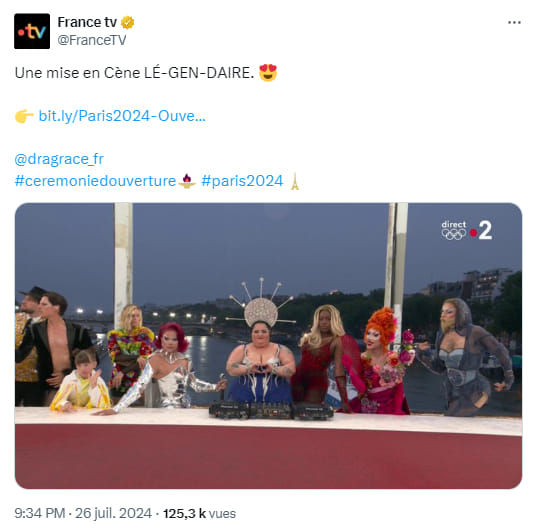
In short and in conclusion, I repeat the reason for my exasperation:
I do not accept that people lie, manipulate and hide behind sleight of hand to shirk their responsibility.
Choosing to provoke and attack, yes, why not, it is a fundamental freedom in a free and democratic society. But then, YOU RECOGNIZE IT and you do not try to make people believe that they did not see what they saw, that you did not do what you did or that people educated in Christian iconography do not know how to recognize the symbols of the Eucharist or its pastiches when you present them to them – especially when you are yourselves a huge ignorant in this matter (Thomas Jolly, Philippe Dagen) or a very clever manipulator lurking in the wings (Patrick Boucheron)! When Leonardo da Vinci meets Machiavelli, you say?
- To those who point out to me that there is no representation of the Last Supper with Bacchus in the foreground, I invite them to look closely at Bijlert’s painting, precisely: Bacchus in the foreground with his bunch of grapes is obviously, in this context of a disguised Last Supper, an allusion to Christ of the Mystical Wine Press, an allegory that any Christian of the modern era could understand. Patrick Machiavelli, sorry, Boucheron, only had to tell Jolly to transform this Bacchus into Katerine in a dish in front of his own pastiche of the Last Supper!
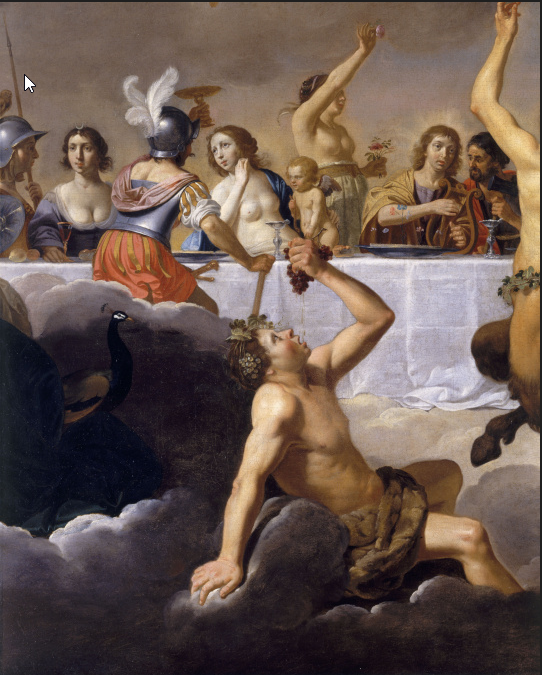
Moreover, even in contemporary art, Cy Twombly’s « Bacchus » (2008) is related to the Christ of the Mystic Winepress: « So one cannot help but think, even if Cy Twombly does not provide any key, in the image of the Mystic Winepress, that of Christ pressed like a bunch of grapes, the blood of the vine and the blood of Christ then becoming one?« .
On Biljert’s painting, the radiant halo of the Apollonian Christ (or of the Christic Apollo) in the center of the table, was also perfectly clear to the spectators of the time, accustomed to seeing the Christ of the Last Supper represented in the same way. This is also the reason why the lesbian Christ in Jolly’s painting, which he pastiches that of Leonardo da Vinci or that of Bijlert, refers in all cases to the theme of the Last Supper!
The Eucharistic symbolism is even more powerful in Jolly’s « painting » than in Bijlert’s, because the reference to Leonardo da Vinci’s fresco is more obvious – the chromatic palette (brightly coloured clothes) and the pattern of the bays in the background opening onto a blue sky are directly reminiscent of Leonardo’s composition. Also see the arrangement of the characters :
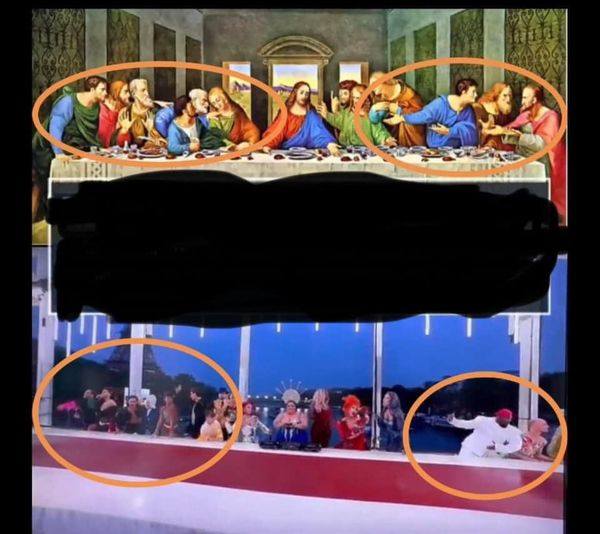
- Knowing that the « Festivity » set was incontestably inspired by an image of the Last Supper, one can then wonder what the little girl is doing sitting on the sacrificial table, on the far right of the picture – to the extent that the table of the last supper is a prefiguration of the altar on which is celebrated, during the mass, the commemoration and the actualization of the sacrifice and the death of Christ:
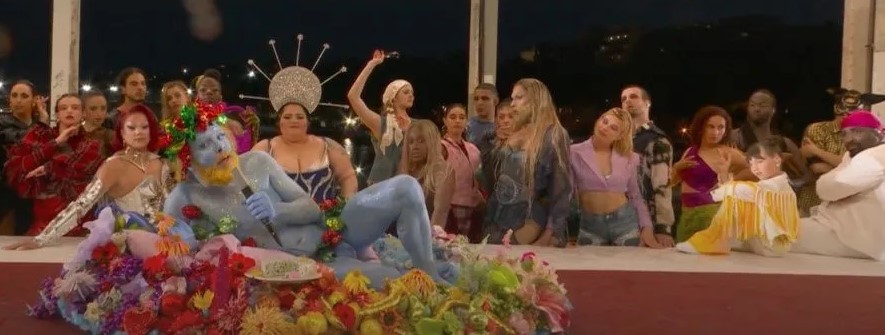
The Eucharistic sacrifice is a symbolic sacrifice, which came to replace the bloody sacrifices of ancient cults. So, what was meant to symbolize here?
- To those who imagine, in front of a Renaissance or modern painting depicting a mythological or pagan theme (or for example in front of Bijlert, which treats a Christian theme under the guise of mythology), that it is « pagan art », I remind you that, whatever its subject, the painting of this period is entirely produced BY AND FOR CHRISTIANS! There is no atheistic art in the Renaissance, any more than there is pagan art – since it is a period that is always intensely religious, where Christian symbolism remains perfectly understood by all. If we take Bijlert’s painting, it is therefore entirely CHRISTIAN ART!
- I am adding this element to the file, because it suggests that Thomas Jolly is indeed obsessed with the image of Christ, and that therefore his parody of the Last Supper could correspond to a recurring desire in him to represent Christ (image taken from his 2016 show on Richard III):
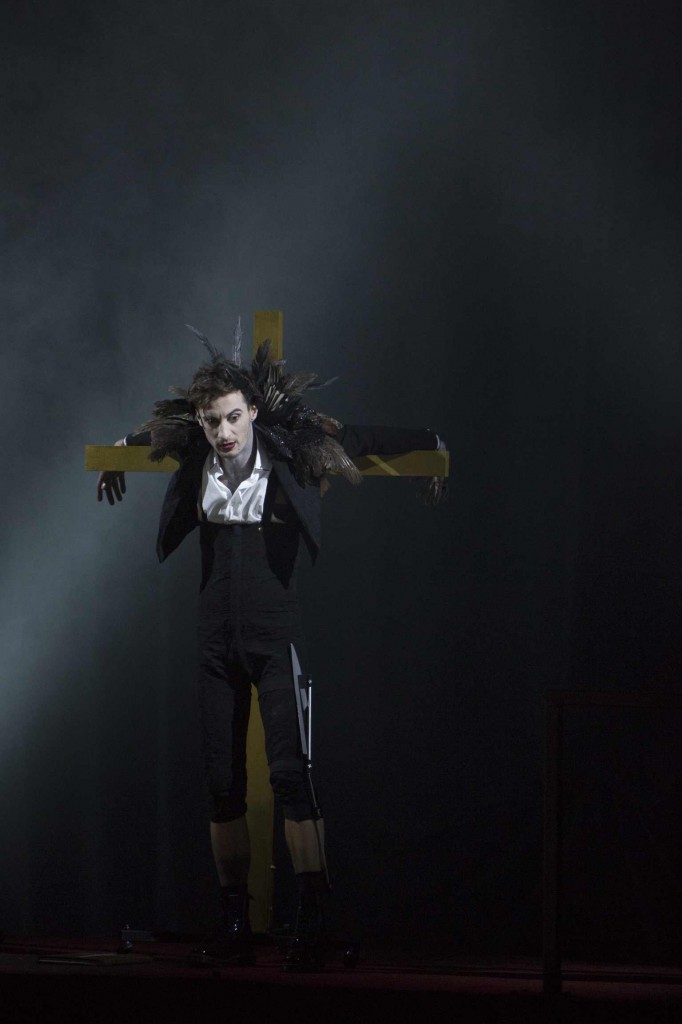
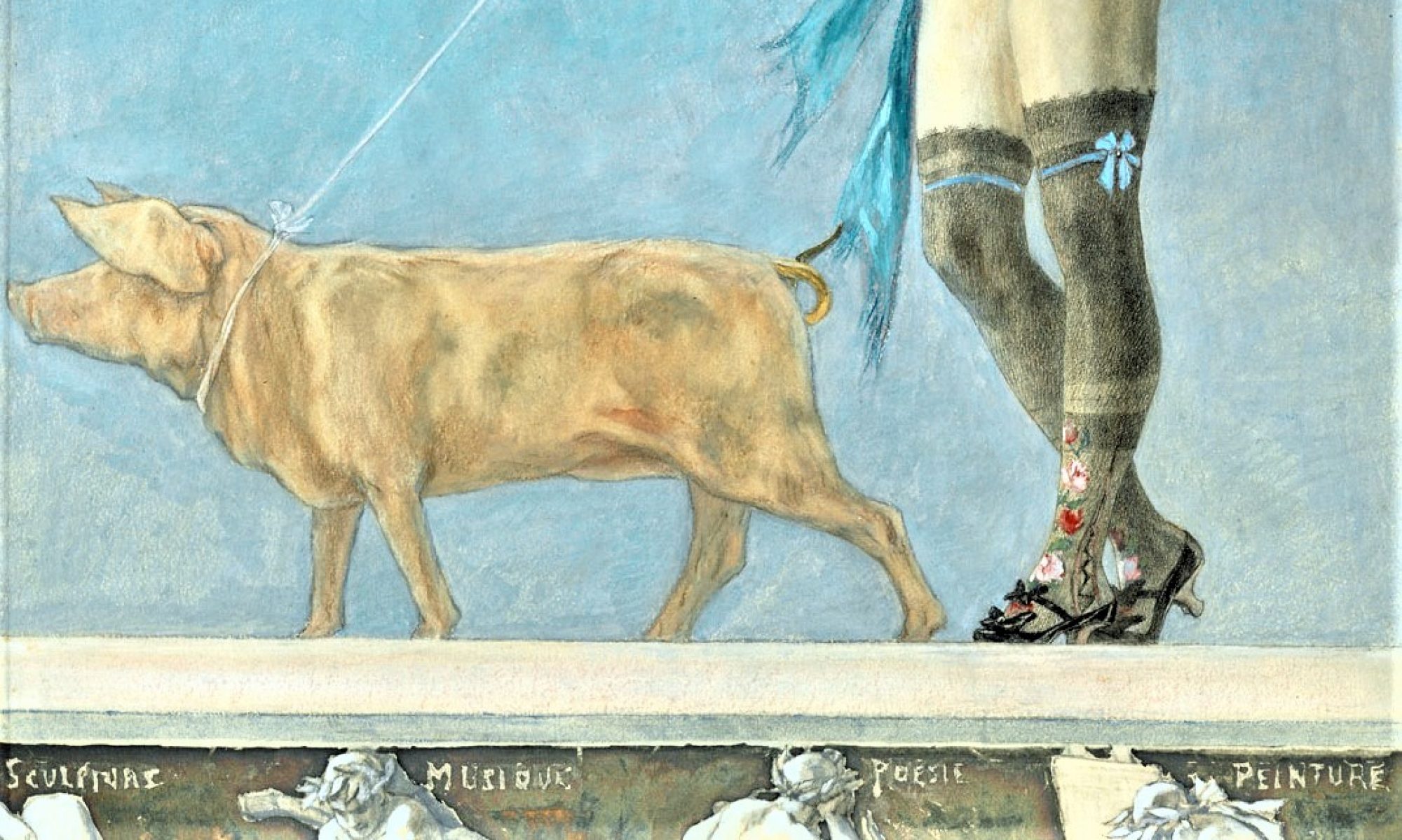

Some feminists believe they can make fun of religion and men. Strong men allowed this mischief back then time to question it…